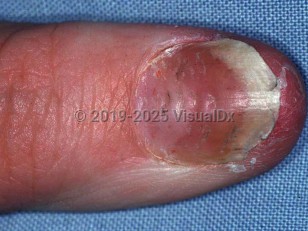Parakeratosis pustulosa - Nail and Distal Digit
Alerts and Notices
Important News & Links
Synopsis

Parakeratosis pustulosa (PKP), also known as Hjorth-Sabouraud disease, is a chronic inflammatory disorder of the nail and surrounding skin. It is seen almost exclusively in girls younger than 7 years. It usually involves one single digit, especially the thumb or the index finger. The skin and nail changes may present months to years prior to presentation. The nail changes include subungual hyperkeratosis, onycholysis, and pitting. Skin involvement is characterized by psoriasiform or chronic eczematous lesions. PKP may not represent a unique entity but rather a clinical phenotype common to inflammatory disorders such as psoriasis or atopic and contact dermatitis. Complete resolution after a period of months or years is observed in over half of affected individuals, with others evolving into psoriasis with nail and/or skin findings.
Codes
ICD10CM:
L21.8 – Other seborrheic dermatitis
SNOMEDCT:
200766001 – Parakeratosis
L21.8 – Other seborrheic dermatitis
SNOMEDCT:
200766001 – Parakeratosis
Look For
Subscription Required
Diagnostic Pearls
Subscription Required
Differential Diagnosis & Pitfalls

To perform a comparison, select diagnoses from the classic differential
Subscription Required
Best Tests
Subscription Required
Management Pearls
Subscription Required
Therapy
Subscription Required
References
Subscription Required
Last Reviewed:09/20/2017
Last Updated:09/20/2017
Last Updated:09/20/2017
Parakeratosis pustulosa - Nail and Distal Digit

